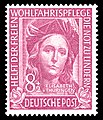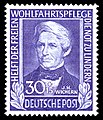Welfare stamp
Welfare stamps are a special kind of supplement stamps that have been appearing in Germany since 1949 . In addition to the pure postage amount, a surcharge is levied that is passed on for charitable purposes.
Deutsche Post currently publishes two different series of stamps of this type every year. The proceeds go to the six general welfare associations (“For Welfare” and Christmas stamps ). A total of almost four billion units have been sold since 1949.
History of welfare stamps
The idea and introduction of the welfare stamps

Kuno Joerger initiated the reintroduction of the welfare stamps in Germany . The then General Secretary of the German Caritas Association was a philatelist and wanted to revive the charity brands of the German Empire . The first German charity stamps from May 1, 1919, in particular, inspired him. These were two postage stamps from the empire with a portrait of Germania . Shortly after the end of the war, these stamps were sold for 5 pfennigs more than their face value with the imprint "5 Pf for war disabled ". Furthermore, he based his idea on the German emergency aid and winter aid stamps, which were issued annually from 1924 to 1940. The welfare stamps should also appear annually based on their model.
Initially, however, only charitable expenses were issued in the form of regional expenses in the Soviet zone of occupation and, in 1948 and 1949, in the French zone of Germany as well. These were still one-time relief actions similar to the war-damaged stamps from 1919, and the recipients of the proceeds were quite different. Kuno Joerger kept trying to expand this idea to all of Germany and eventually succeeded. The Deutsche Post approved the issuance of its own welfare stamps on December 14, 1949. The four special stamps finally appeared at the counters under the appeal “Help and give joy, buy charity stamps”. " Helpers of Humanity " was chosen as the theme for the issue . These were Elisabeth of Thuringia , Paracelsus von Hohenheim , Friedrich Froebel and Johann Hinrich Wichern .
Initial difficulties and the subsequent welfare series
The high-quality designed helpers of mankind from December 1949 did not bring the desired success because the sales expectations were clearly missed. This led to an extension of the sales period beyond the planned time and the cancellation of a separate edition in 1950. In 1951, however, another attempt was made and the production of the second series "Helfer der Menschheit" began on October 23, 1951 appeared.
In the years that followed, the theme remained true to the issue and, up to 1955, five further series were issued with portraits of special “helpers to humanity” on four values. From 1956 to 1959 the series “Helpers of Mankind” was themed and showed professions from the fields of medicine, coal mining and agriculture, each with a special representative of this branch. The series of welfare stamps from 1959 was seamlessly provided with motifs from the fairy tales of the Brothers Grimm , in the first series again with a portrait, here the Brothers Grimm are shown with the addition “Helpers of Mankind”.
Thanks to numerous improvements, the sales figures have steadily increased. For example, the customer could soon not only buy the welfare stamps from the post office, but also directly from the institutions supported. Furthermore, efforts were made to draw attention to this stamp series through advertising. In 1956, the then Federal President Theodor Heuss , who was very committed to these issues, took over the patronage . Since then, all other Federal Presidents have followed Theodor Heuss in this matter. Shortly before they are issued, the stamps are traditionally handed over to the incumbent Federal President in Bellevue Palace , usually by the Federal Minister of Finance . Since 1964, the welfare stamps appeared slightly different in Berlin , which had its own stamp issues due to the Allied reservations.
The welfare stamps were widely distributed through the television program Vergißmeinnicht and the associated competition from 1964, for which a whole set of welfare stamps had to be stuck on postcards (in addition to the postage).
One essential element distinguishes all editions from all other special stamps from the start: While special stamps are regularly sold until the entire edition has been sold, there is a precise and pre-determined sales period for welfare stamps. Unsold copies are regularly destroyed after the sales period has expired.
The welfare stamps today
Nowadays, two different welfare series appear annually. In addition to the usual welfare series, one and later two Christmas stamps have been appearing since 1969. Today's circulation figures are around 3 million pieces per brand, the peak values have already been more than 20 million pieces for individual brands. However, the circulation figures do not correctly reflect the sales of the stamps, as the institutions that are the recipients of the hammer purchase the stamps at the pure postage value (i.e. without the hammer) and sell the stamps themselves, but above all their own mail items with these stamps can frank.
- The first post-war series from 1949, Helpers of Mankind
List of charity stamps
German Federal Post
The images of the brands and details of the individual issues can be accessed via the link for the respective year of issue.
| Year of issue | Welfare stamp | Christmas stamp (from 1969) |
|---|---|---|
| 1949 | Helpers of Humanity I. | - |
| 1951 | Helpers of Humanity II | - |
| 1952 | Helpers of Humanity III | - |
| 1953 | Helpers of Humanity IV | - |
| 1954 | Helper of humanity v | - |
| 1955 | Helpers of Humanity VI | - |
| 1956 | Helpers of Humanity VII | - |
| 1957 | Helpers of Humanity VIII (Miners) | - |
| 1958 | Helpers of Mankind IX (farm workers) | - |
| 1959 | Fairy tale I ( Sterntaler ) | - |
| 1960 | Fairy tale II ( Little Red Riding Hood ) | - |
| 1961 | Fairy tale III ( Hansel and Gretel ) | - |
| 1962 | Fairy tale IV ( Snow White ) | - |
| 1963 | Fairy tale V ( Seven Little Goats ) | - |
| 1964 | Fairy tale VI ( Sleeping Beauty ) | - |
| 1965 | Fairy tale VII ( Cinderella ) | - |
| 1966 | Fairy tale VIII ( frog prince ) | - |
| 1967 | Fairy tale IX ( Mrs. Holle ) | - |
| 1968 | Old toy I ( dolls ) | - |
| 1969 | Old toy II ( tin figures ) | Tin figure (around 1850): Birth of Christ |
| 1970 | Old toy III ( puppet theater ) | Angel: Nativity figure from the Ursuline convent Innsbruck (18th century) |
| 1971 | Old toy IV ( wooden toy ) | Wood-turned Christmas angel |
| 1972 | Old toy V ( chess pieces ) | The three kings |
| 1973 | Musical instruments | Christmas star made of paper |
| 1974 | Flowers | Poinsettia: Poinsettia (Euphorbia pulcherrima) |
| 1975 | Alpine flowers | Bund: Schneerose (Helleborus niger) Berlin: Schneeheide |
| 1976 | Garden flowers | Block edition: Marienfenster of the Frauenkirche in Esslingen am Neckar (excerpt) |
| 1977 | Meadow flowers | Block edition: glass window (detail) from St. Gereon in Cologne |
| 1978 | Forest flowers | Block edition: The Christ Child from a window of the Frauenkirche in Munich |
| 1979 | Fruits of the forest | Decorative initial of a manuscript from the former Cistercian Abbey of Altenberg |
| 1980 | Arable herbs | Illumination from a manuscript from Altomünster (12th century) |
| 1981 | Bog, marsh meadow and aquatic plants | Reverse glass painting from Sandl (Upper Austria) |
| 1982 | Garden roses | Wooden panel by Bertram von Minden |
| 1983 | Endangered alpine flowers | Carol singers |
| 1984 | Orchids | Saint Martin |
| 1985 | Miniatures | Painting by Hans Baldung on the high altar of the Freiburg Minster |
| 1986 | Precious glasses | Wing of the Ortenberg Altarpiece |
| 1987 | Gold and silversmithing I | Miniature from an English psalter |
| 1988 | Gold and silversmithing II | Miniature from the Gospel Book of Henry the Lion |
| 1989 | Mail delivery I | Details from the " English greeting " by Veit Stoss in the Lorenz Church in Nuremberg |
| 1990 | Mail transport II | Christmas crafts |
| 1991 | Historic post houses | Panel paintings by Martin Schongauer |
| 1992 | Precious old clocks | Relief details from the Sankt-Annen-Kirche in Annaberg-Buchholz |
| 1993 | German costumes I | Reliefs from the Blaubeuren monastery church |
| 1994 | German costumes II | Painting by Hans Memling from the Johannis Hospital in Bruges |
Federal Republic of Germany (Deutsche Post AG)
The images of the brands and details of the individual issues can be accessed via the link for the respective year of issue.
| Year of issue | Welfare stamp | Christmas stamp |
|---|---|---|
| 1995 | Farmhouses I | Details of the Marie window in the Cathedral of Augsburg |
| 1996 | Farmhouses II | Miniatures from the Pericope Book of Henry II. |
| 1997 | Water and windmills | |
| 1998 | Endangered species of birds | |
| 1999 | The cosmos | |
| 2000 | German-speaking film actors | Painting by Conrad von Soest / Nativity scene as a transparency |
| 2001 | International film actor | Painting by Alfredo Roldán and Jusepe de Ribera (also as a block edition with the Spanish Post) |
| 2002 | Vintage automobiles I. | Painting by Rogier van der Weyden |
| 2003 | Classic Cars II | |
| 2004 | Climates | Painting by Peter Paul Rubens |
| 2005 | Native butterflies | Painting by Stefan Lochner |
| 2006 | Locomotives | Painting by Master Francke |
| 2007 | Pets | Motifs from the Gospel of Luke |
| 2008 | Aircraft | Painting by Albrecht Dürer and Raffael |
| 2009 | Celestial phenomena | Initials from the Hoya Missal |
| 2010 | fruit | Details from the crib in the Munich Liebfrauenkirche |
| 2011 | Motifs by Loriot | St. Martin, St. Nicholas |
| 2012 | Gemstones | Christmas chapel |
| 2013 | Flowering trees | Star of Bethlehem |
| 2014 | Fairy tale X ( Hansel and Gretel ) | Star of Bethlehem |
| 2015 | Fairy Tale XI ( Sleeping Beauty ) | silent Night |
| 2016 | Fairy tale XII ( Little Red Riding Hood ) | The shepherds in the field |
| 2017 | Fairy tale XIII ( The Bremen Town Musicians ) | From the sky above |
| 2018 | Fairy Tale XIV ( The Frog King ) | Church window |
| 2019 | Fairy Tale XV ( The Brave Little Tailor ) | Church window "The Nativity" |
| 2020 | Fairy Tale XVI ( The Wolf and the Seven Young Goats ) |
See also
- Audrey Hepburn charity stamp
- Surcharge mark
- Pro Juventute = For young people in Switzerland
literature
-
Handheld dictionary of postal services
- 2nd edition, p. 800
- 1st supplement to 2nd edition, p. 130
Web links
Individual evidence
- ↑ Postage with a Heart ( Memento from February 16, 2015 in the Internet Archive ) about the use of the proceeds, Wohlfahrtsmarken.de
- ↑ Forget-Me-Not on fernsehlexikon.de



